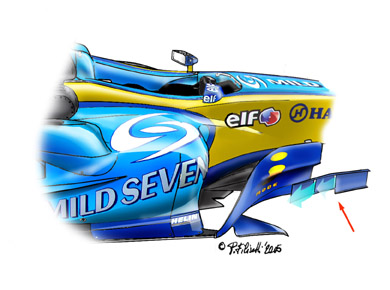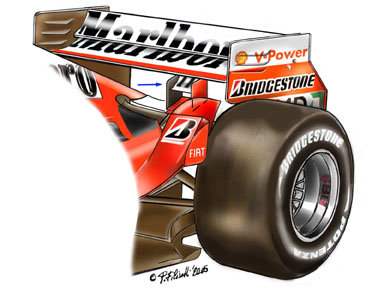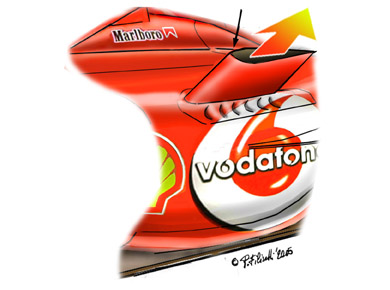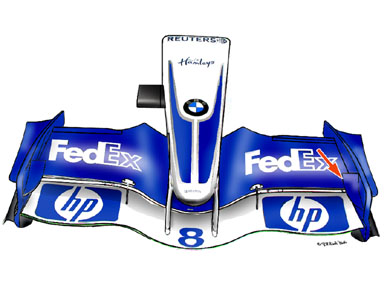Sunday, April 03, 2005
BAHRAIN GP 2005 TECHNICAL ANALYSIS

Renault R25 - front barge boards
A very complex design for Bahrain. Three elements are kept together by two horizontal edges and are separated from eachother by vertical gills that split the airflow into three portions, all directed outwards to reduce the turbulence generated by the front wheels and to increase the airflow, and hence downforce, underneath the car. The result is a very aerodynamically stable Renault R25.

Ferrari F2005 - additional wing
For Bahrain, Ferrari have added a small wing on top of the rear light support, similar to the solution introduced by Williams in Australia. It provides some highly effective additional downforce over the rear axle, improving the traction of the car. Sauber too have adopted a similar design here, now that it has passed the mandatory FIA crash tests.

Ferrari F2005 - cooling chimneys
Another obvious change on the F2005 for Bahrain is the chimneys on top of the sidepods. These have replaced the tiny vertical fins seen on the launch car. Of course, the main function of these is to improve the car's cooling capabilities in the desert heat, but they also have an aerodynamic function, diverting airflow and acting in conjunction with the small winglets that have been added behind them, in a similar fashion to on the old (F2004 M) car.
Some changes to the new Ferrari for Bahrain from the launch version. At the bottom of the barge boards a horizontal fin added (1), similar to that on the Renault R25, creating a sort of splitter for the outermost portion of the airflow, part of which it directs under the floor of the car to maximise the downforce generated. The saw-tooth profile on the bottom of the barge boards has been retained.

Sauber C24 - engine air filter
The sand didn't prove as big a problem as expected at last year's inaugural Bahrain race, but the teams are still taking some additional filtering measures. A thicker air filter than normal features more layers and more lies to each layer, reducing its permeability and protect the precious V10 from even the tiniest grains, which can be just a few microns wide.

Williams FW27 - front wing modifications
The evolution of the FW27's front wing continues in Bahrain with the small winglets inside the endplates reduced in section (previously they curved upwards on their inside edge). This small change is hugely important to the front-end balance of the car and hence to improved tyre wear and cornering. The reduced winglet width reflects the higher top speed at this track, where it is not necessary to increase the downforce level under braking.
